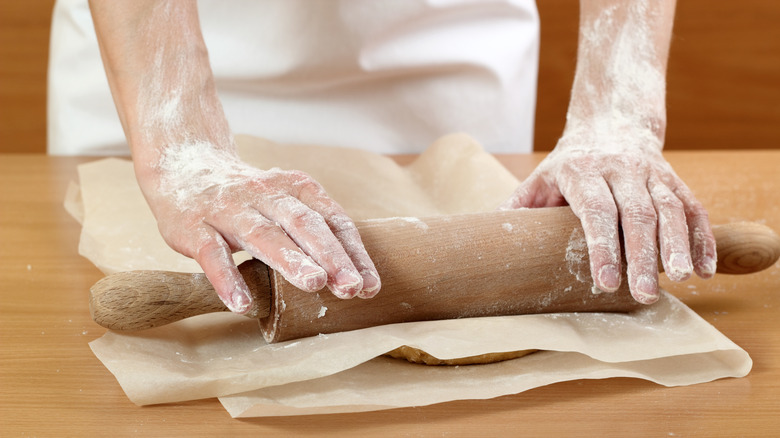The Parchment Paper Trick For Rolling Out The Perfect Cookie Dough
There's a good reason why you may be more tempted to try out a drop cookie recipe, where you simply place spoonfuls of dough on your baking sheet, instead of a cut-out cookie recipe — the former are usually more low-effort than rolled cookies. After all, the process of rolling out cookie dough can be challenging for many reasons.
First of all, there's the mess factor. In order to prevent your dough from sticking to both your countertop and your rolling pin, you likely sprinkle a bit of flour over both surfaces. However, that flour often ends up getting all over your kitchen and can be a pain to clean up. Not to mention, you might be risking your cookies not turning out quite right. As Loafy Bread explains, flouring your surface a little too aggressively could cause your dough to absorb a bit too much of the flour, making your cookies too tough.
However, some doughs are just stickier than others, and without enough flour, you might find your dough clinging to your rolling pin. One wrong move and your carefully flattened sheet of dough is torn and you have to start all over again. Chilling your dough can help a little bit with this, as The Cookie Elf outlines, but it's not a perfect solution.
The ideal trick for never again stressing about rolling out a batch of cookie dough involves a simple tool that many bakers already have in their kitchens – parchment paper.
A parchment paper sandwich
While many cooks line their baking sheets with parchment paper, you'll want to grab your roll of the baking staple during the dough-rolling stage as well. It's the secret weapon for rolling out your dough.
In order to create a perfect layer of rolled cookie dough with no mess and no risk of incorporating too much flour into the dough, you just need to spread your dough over a piece of parchment paper. Then, put another layer of parchment paper on top of the dough, essentially sandwiching the dough between the two layers of paper. When the dough is nestled between the layers, you can effortlessly roll it out with no issues. Your rolling pin won't stick to the dough, since the dough is all protected by the paper. Then, you'll be able to just peel the parchment layers off the dough when it's at the desired thickness.
As an added bonus, this tip is fantastic for delicate cut-out cookies that you run the risk of ripping when transferring to your baking sheet. That's because you can peel off the top parchment layer, cut out your cookies, remove the excess dough, and then take the entire sheet of parchment topped with your cut-out cookies and plop it onto your baking sheet. It's basically foolproof.
For best results, as Nielsen Massey outlines, you may also want to dip your cookie cutter into flour so that you get clean, crisp edges.

